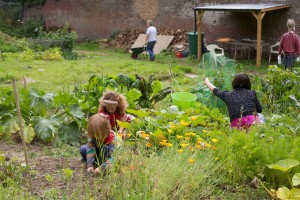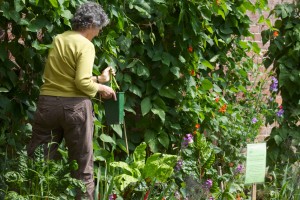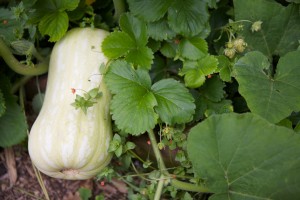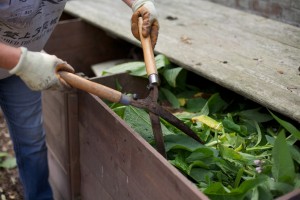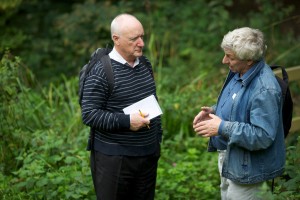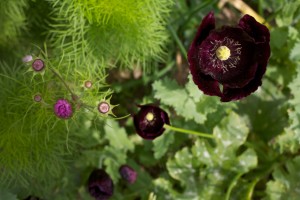Bohemia Walled Garden . . . 2 years on
By John Humphries, Dec 2011
The Bohemia Walled Garden was ‘adopted’ two years ago by a group of local volunteers determined to bring it back into useful service. In August this year the Voice was kindly invited to have a look at the wonderful progress made by the Bohemia Walled Garden Association. We were kindly shown around by Bob Hart and Sue Thomson. All the pictures are by Sin Boskurt (unless otherwise stated).
The first thing that strikes a visitor to the walled garden is how neat and tidy everything looks. Such a change from just two short years ago: all the scrub, brush and weeds have gone (well, most of them) and have been replaced with lawns, flower beds, vegetable patches, a beehive, composters, sheds and . . . scarecrows. It’s a wonderful tribute to what hard work, boundless enthusiasm and dogged determination can achieve. Congratulations to Sue, Bob and the team.
LAWN. The walled garden now boasts a very pleasant lawn; it is used as a greetings area near the entrance and for social events and can accommodate a large marquee. A lot of very hard work went into preparing the lawn area: it was a mass of tangled brambles and young oak, sycamore & birch trees. Once cleared of vegetation, the ground had to be dug over several times to rid the soil of weeds & tangled roots. It was then levelled with spades and rakes … and finally strewn with grass seed. Among the many plants spotted on our tour were giant (12ft) sunflowers, sweet corn, spinach, poppy, rudbeckia, cosmos, beetroot and chard, rhubarb, squash, strawberries and oregano.
COMPOSTERS. There are many different designs of composters around the garden (example below). A special composter uses comfrey leaves which are grown in the garden. A mysterious ‘green cone’ which looks like an upturned bucket, is in fact a composter which will tackle cooked food – when we opened it for a look, a hundred flies flew out. There’s a wormery which consists of a small stack of plastic trays: the worms live on kitchen waste and old newspaper, producing a liquid manure which drips down to a collecting tray at the bottom. The liquid is spread on the garden as fertilizer. There are several wooden composters and a few plastic ones. There’s also a large wire cage for fallen leaves. The composting site/paraphernalia was paid for by a £500 grant from the ESCC, to support responsible use of natural resources and recycling.
URINAL. Bob is keen to see a simple urinal established in the southeast corner of the garden (the prevaIling wind is westerly). “It’ll be simplicity itself”, says Bob, “a pile of straw behind a plain privacy screen; men will pee directly onto the straw, women can use ‘pee-mates’, like the ones used at festivals”. Periodically straw is added to the compost material. Sue added “Initially we had wanted a composting toilet, which would require considerable planning & expense. Then we considered the straw bale option. Our most recent idea is to have a screen and simply use a bucket. This way every user would be responsible for themselves, by emptying the liquid contents directly onto some composting vegetation. Although the straw is good in principle, it requires some member to remove it & position it onto the compost. Any volunteers?” After a lively committee meeting in August, a compromise was reached: there will be both a bale of straw and a bucket – what a relief.
WALLS. A large hole has been bricked up by HBC, but a missing section of wall in the south-east corner has not yet been attended to. The cost of repair of the wall, requiring 10,000 bricks, is estimated as at least £70,000 including VAT and a contingency sum. This section is thought to have been brought down in 1987 by a fallen tree, during the great storm. The temporary ‘Heras’ fencing seems to be doing a good job, keeping out those who have no business in the garden. Bob: “About a year ago, some vandals broke in and stole a few tools and scarecrows – now the fence has been strengthened and we don’t keep any tools or anything of value on the site”.
THE SLAVE TRADE. The walled garden (writes Bob Hart) was originally used mainly as a fruit garden with vegetables being grown in a separate area above the garden, nearer the original house. I believe there used to be greenhouses near the present Horntye Park Sports Centre’s all-weather pitch. On the inside of the walled garden are a huge number of metal eyes and even some remaining wire – used for training fruit-bearing bushes.
The Brisco family was connected with Summerfields and Bohemia House. They were very wealthy, their money coming from the slave trade: Wastel Brisco had 500 registered slaves, all working on sugar plantations at St Kitts in the Caribbean. The Brisco family originally had a family seat at Crofton Hall, Thursby in Cumberland that was owned without a sale for 500 years. The junior branch of the family came to Sussex, and Bohemia House (Summerfields House) at Bohemia & Coghurst Hall at Ivy House Lane, were their estates in this area. This branch of the Brisco family passed on without issue and several are buried at Church-in-the-Wood. Other Brisco family, up to the 9th Baronet, became farmers in New Zealand and the USA.
Unlike other wealthy families, like Brassey & North, they did not contribute to the quality of life of local people and the number of legal disputes recorded must have taken up a lot of time. The closure of the footpath from the town to the house and an erection of a wall to keep out the riff-raff was typical. One of the last to survive was Sarah Brisco who did make a number of small bequests of a few thousand pounds to local charitable organisations out of her £161,507 gross estate in 1901.
The Bohemia Walled Garden Association
Membership of the BWGA is free. Sue Thomson (bohemiawga@yahoo.co.uk), Bob Hart (01424 720993. 07712 591315. bob.hart@yahoo.co.uk). Bohemia Walled Garden Association, c/o Bohemia Village Voice, 79, Bohemia Road, St Leonards, Sussex, TN37 6RJ.
www.bohemiawga.weebly.com
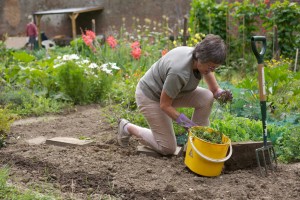
Sally Hick rents a small plot, even though she’s got a house with a garden “It’s just so much easier to grow stuff here – my garden at home is shaded, here everything just shoots up. I try to get here at least once a week”. There are about 40 individual plots, from 7 to 20 square metres. Users pay £1 per square metre per year. The members of the BWGA have their own patch which is worked by anyone and everyone for the benefit of the group. Unfortunately, at present, there are no spaces left; but there is a waiting list. Money from plot rents is used to pay the insurance, etc.
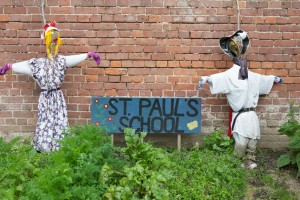
St Paul’s School and St Mary, Star of the Sea both use the garden: each has a 30m2 plot. We counted no less than six scarecrows in the garden – most are made by children and give the garden a friendly feel. Although no crows were seen, Sue Thomson says “Unfortunately the scarecrows have not kept the pigeons out”.
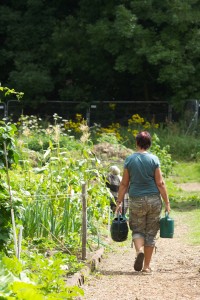
Chris M carrying water. This can be collected from a pond conveniently situated just outside the entrance to the garden. There are also a couple of sheds in the garden and run-off from these is collected in a pair of large tanks.
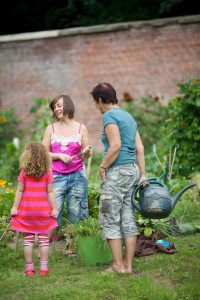
Daniella (left) with Chris M. Note the new section of specially made moulded coping stones replaced by Booker & Best (commissioned by HBC). Without the coping stones, the wall quickly becomes damaged through rain.
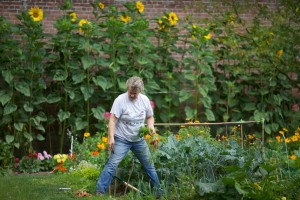
Lesley Bruce in vegetable patch. Courgettes, runner beans, strawberries, onions, sweetcorn, yellow vine tomatoes, red tomatoes, squash, beetroot and round beans were all seen on our vist.
![During a Heritage Open Day, a pirate scarecrow decided to give up his pole for a bit of pole-dancing and have a whirl with a BWGA member, Michel Guille. [photo: Vanessa Saunders] During a Heritage Open Day, a pirate scarecrow decided to give up his pole for a bit of pole-dancing and have a whirl with a BWGA member, Michel Guille. [photo: Vanessa Saunders]](http://www.bohemiavillage.com/wp-content/uploads/bv/Pirate-scarecrow-Michel-231x300.jpg)
During a Heritage Open Day, a pirate scarecrow decided to give up his pole for a bit of pole-dancing and have a whirl with a BWGA member, Michel Guille.
[photo: Vanessa Saunders]
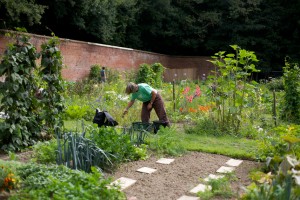
Anne B weeding. Note the reed screen in the corner: this hides a working beehive. The bees have been given this sheltered spot in the corner, which is not too hot or exposed to winds. The screen forces the bees to fly up & out, above the heads of people. Sisters Rebecca and Leonie Nolan look after the bees.
Leave a Response
You must be logged in to post a comment.

